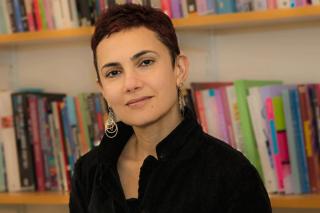Jyoti Puri, Professor of Sociology and Hazel Dick Leonard Chair was the recipient of the 2021 Jessie Bernard Award, given annually in recognition of work with broad scholarly impact that has “enlarged the horizons of sociology to encompass fully the role of women in society.” Puri was selected for her internationally-renowned scholarship in the field of feminist research. She shared with us her new subject of research, death in migrant communities.
Tell us about your current research.
The arc of my work has been around questions of gender and sexuality. Over the last few years, I have pivoted to researching death and migrant funeral practices.
Many years ago, I saw a photograph taken in 1907 of the cremation of a Sikh migrant in North America. The caption on the photo indicated that the mayor had not given permission to the migrants to cremate the body [per Sikh custom], so they took the body into the forest in the wee hours of the morning to complete the ritual. That image simmered in my mind for many years, and made me confront what it is like to die on soil that is not one’s own, where one is seen as not belonging.
This particular photo was taken by a white Canadian photographer. The camera had an unobstructed view, so clearly the mourners were aware the photo was being taken. There was also a clutch of white observers present. It was not at all typical for Sikh migrants to have photos taken at funerals; they did not believe in saving keepsakes from their dead. Cremation was intended to destroy the body and release the soul, and the ashes were then released in a flowing body of water. I was moved by the photo, and my task is to tie all of the details together and understand how this and other such photos came to be and what they tell us about that historical moment and its legacies.
I’ve also learned that the photo circulated as a postcard, as did many other photos of cremations and cemeteries at that time. It was mailed within British Columbia and most likely circulated among white people. I haven’t seen any indication of such postcards circulating within the migrant communities. Part of my job is to tease out the broader context that allows people to see this as a spectacle. What is the interest? What is the context fueling and shaping that interest? How do we interpret that interest, and what are the implications of circulating this image as a postcard?
What challenges have arisen from this pivot in your research?
I’m inspired by reading in new areas, and I’ve found excitement in my research about death. Having to educate yourself can be daunting, but is very rewarding. It has meant researching migration and reading historical archives, which I’ve never done before. Sometimes it is completely overwhelming, but I don’t know what project worth doing doesn’t make you feel that way. You come out on the other side with something interesting to say, along with your own self-growth and development. This project is extending me and energizing me in all kinds of ways.
Tell us about your process
Most of the research is online, as these are very well-documented historical archives. Getting access to the Harvard Divinity School libraries was an opening point. I found a whole host of travelogs written by US citizens traveling in colonial India (now South Asia), with extensive commentaries about death.
There is a trove of photos in the Library of Congress and other databases, and I’ve pulled together information about cremation and burials, particularly of migrants. Some images of Sikh migrants look like family photos — there are groups of people together, and from the way they are dressed you can see that they’ve consented to having a photo taken. Many others were taken of Sikh laborers working in fields or on railroads, and it’s not clear if they knew their photo was being taken, or if they consented.
Your research encompasses a broad range of topics: death, feminism, racism, sexuality. Is there a through line that connects all of these interests?
My previous research was concerned with how states and nations regulate bodies, sex, and gender, with an underlying concern about preservation of social order. When race and religion are different, it can be seen as a threat to social order, and examining those perceived threats and how the differences are regulated by state and nation are the points of continuity in my research.
Any advice for students? What have you enjoyed about teaching at Simmons?
Follow your interests and your passions — they are there for a reason. Research that area and read and educate yourself. Immersing yourself in the available material can show you where the gaps are, and you can see how you can contribute and add new perspectives and understandings.
The nicest part of teaching for 25 years is the opportunity to see students flourish. I’ve seen students come into their own, with their own careers and families. Many have become my peers, and that has been very fulfilling.

